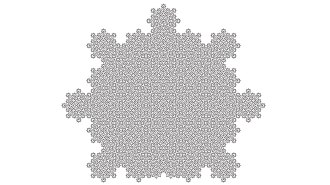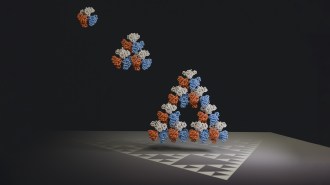Anyone who has waited for a bus in the city has probably casually observed that, after an inordinately long wait, two or three buses often come along at the same time.

The question of why such bunching seems to happen has prompted all sorts of speculation. Some claim that bus bunching is actually a rare occurrence, but passengers tend to forget the much larger number of times when a single bus arrives. Others posit that bus drivers simply like to travel in packs.
Mathematical models that simulate traffic flow confirm that bus bunching is a real phenomenon. Even though buses leave their depot at regular intervals, the number of passengers standing at bus stops along a route can vary considerably. The unpredictability in the number of passengers assembled at a given stop has a strong effect on a bus’s timeliness.
Suppose, for instance, that a large group of passengers happens to cluster at a particular stop. It takes longer than normal for the passengers to board the first bus that arrives, so the bus behind it catches up a little. When the second bus arrives at the stop, there would have been less time for more passengers to assemble, so the bus goes on its way quickly. Meanwhile, the lead bus arrives at its next stop later than normal, so there would have been more time for additional passengers to join the crowd. After several more stops, the second bus inevitably catches up with the first.
Once one bus catches up with the other, the two buses act as if they were a single bus. If the route is a long one, a third bus could eventually catch up with the first two.
Bus transport in Cuernavaca, Mexico, operates differently. Although passengers wait at bus stops along specified routes, there are no schedules. Drivers own their buses and compete for passengers. To pick up as many passengers as possible, they constantly slow down or speed up, depending on the number of other buses in the vicinity. Indeed, drivers even employ people to stand at checkpoints along a route and tell them when the last bus left a particular area so they can adjust their speed accordingly, staying far enough behind the preceding bus without letting the following bus catch up.
Despite the apparently chaotic transport system, there is a sort of statistical order in the collective behavior of the vehicles. Physicists Petr Seba and Milan Krbalek of the Czech Academy of Sciences have found that Cuernavaca buses move about like randomly interacting subatomic particles. This activity can be described in terms of mathematical expressions called random matrices, which were originally used to describe the quantum energy levels of large atoms or heavy atomic nuclei.
In the 1970s, theoretical physicists started to use sets of random matrices (with certain, specified properties) as mathematical models of complex quantum systems. In a random matrix, the rows and columns are filled with numbers randomly selected from a normal, or Gaussian, distribution. (Imagine randomly choosing numbered balls from an urn, in which certain numbers are represented more often than others.) By solving a sufficiently large random matrix, physicists can determine a system’s “typical” energy levels. Combining the results of many such calculations, they can come up with statistical laws about those energy levels.
Seba and Krbalek applied random matrix theory to the arrival times of Cuernavaca buses. They recorded a total of 3,500 arrivals during a period of 27 days at a spot near the city’s center on one particular bus route.
The researchers modeled the buses as a one-dimensional gas–particles moving and interacting along a line. “Although this system is far from being of quantum origin, the fluctuations in the time intervals between subsequent buses arriving at a given bus stop display exactly the same features as observed in the chaotic quantum transport,” Seba says. In effect, there is much less clustering than observed for buses operating according to a rigid timetable.
Seba argues that the unregulated Mexican buses actually get passengers where they need to go more efficiently than buses run on inflexible schedules.
Other studies suggest that statistics based on random matrix theory may also apply to variations in distance between cars on German highways. Interestingly, mathematicians have themselves applied random matrix theory to such questions as the distribution of prime numbers and the possible arrangements of shuffled playing cards.






